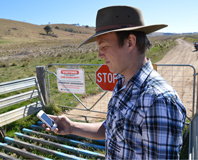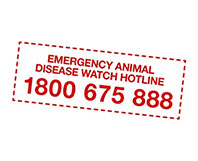Read the latest information on
Foot-and-mouth disease
 Australia is very fortunate to be free of many diseases and pests that could devastate our livestock industries. This freedom from disease allows us to produce a premium product and access markets all over the world.
Australia is very fortunate to be free of many diseases and pests that could devastate our livestock industries. This freedom from disease allows us to produce a premium product and access markets all over the world.
Whilst we have been fortunate to date, increased international trade, movements of people and products all around the world and the uncertain impacts of climate change increasingly threaten our biosecurity status. It is vital that we continually work to increase our preparedness for an outbreak.
Diseases of significance to our agricultural sector are listed on our notifiable disease lists. It’s in everyone’s interest for suspected or confirmed notifiable animal diseases to be reported to agricultural authorities. Reporting has two key benefits.
In Australia, we have animal diseases that are nationally notifiable, meaning they must be reported no matter where you are located in the country. We also have state- or territory-specific notifiable diseases, that are specific to the state and territory you live in.
So how do we recognise potential cases of notifiable disease and report them?
Our nationally notifiable disease list for terrestrial animals lists a whopping 98 diseases. This is a lot of diseases for anyone to remember, not to mention all the signs that they cause. So that raises the questions, how do you know when you might have a notifiable disease and when do you need to report it?
The best rule of thumb? If in doubt, report it!
Anything unusual in your livestock is worth reporting to be on the safe side. This can include one or a combination of the following:
I spotted something unusual, what now?
First step: report it. In the event of an exotic disease, failure to report unusual signs of disease quickly means it could be spreading uncontrolled. It could also mean a lack of compensation under an emergency response arrangement.
 You can report it to your local vet, your state or territory’s agricultural department or the Emergency Animal Disease Hotline on 1800 675 888. This number is a 24 hour hotline – make sure you have it handy or program it into your phone – if you ever need it, it pays to have the number on hand so you can access it quickly.
You can report it to your local vet, your state or territory’s agricultural department or the Emergency Animal Disease Hotline on 1800 675 888. This number is a 24 hour hotline – make sure you have it handy or program it into your phone – if you ever need it, it pays to have the number on hand so you can access it quickly.
Based on the scenario of foot and mouth disease, the Australian Bureau of Agricultural and Resource Economics and Sciences (ABARES) estimated the difference in cost between a small and large outbreak in Australia [1]. To keep an outbreak small, reporting and detection of the disease needs to be timely, and as you can see this has the potential to significantly reduce the cost of an outbreak.
In recognition of the importance of reporting and investigating possible signs of notifiable diseases, there are subsidies or programs available to assist in the cost of undertaking investigations into unusual signs of disease. The details of these programs depend on where your property is located so make sure you talk to your private or government vet to find out what might be available to you.
The vast majority of the time, the cause of the signs in your livestock will turn out to be straightforward. Even so, this does not mean that reporting was unnecessary. It can help you understand what is going on in your livestock and treat the cause, maximising your production. It also helps Australia demonstrate our freedom from exotic diseases.
Want to learn more about disease and test your knowledge?
Check out our Facebook page @AHAOutAndAbout every Wednesday for some case studies on interesting signs of disease in livestock. We post about a particular endemic or exotic disease and leave it up to you to guess what it could be. Follow us on Facebook and get involved and test your knowledge.
[1] Potential socio‐economic impacts of an outbreak of foot and mouth disease in Australia (ABARES)
This article was contributed by Jess Rummery, AHA’s Biosecurity and Extension Manager for Northern Australia